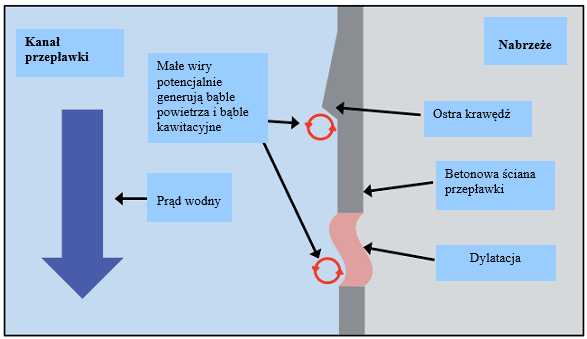RECOMMENDATIONS FOR CONSTRUCTION IN FISHWAYS
Recommendations for construction in fishways
The effectiveness of the systems (optical and acoustic) used to monitor fish passes depends mainly on the hydrological conditions prevailing in the water. The work of optical systems is strongly dependent on the degree of water transparency. Transparency of water in practice does not have a major impact on the correct operation of acoustic systems.
Often, however, the design of monitoring systems is based on the use of both optics and acoustics. In these cases, the degree of aeration and water transparency is important.
The basic requirement for both types of monitoring systems is to keep as little water as possible where the monitoring equipment is installed. Air bubbles in the water cause significant disturbances in the operation of the systems. Especially in the case of fast currents, larger air bubbles take the form of a spindle-like shape, from which the echo can be incorrectly recognised as an echo from a fish.
Such a shape of air bubbles in conditions of low water transparency may cause misidentification of the image from the camera and the qualification of larger bubbles as quickly moving fish.
Causes of reflections in water
The basis of all acoustic systems is the directional transmission of sound at different frequencies through the water and the recording of its reflections by appropriate receivers. The reflection (echo) occurs on the boundary layers between the water and the water bed or fish. Similarly, any air bubbles in the water cause very pronounced boundary layers. In conditions where the water is not aerated, the sound wave penetrates through it without hindrance, enabling correct transmission and correct readings of data about objects in the water. But if air appears in the way of a sound wave in the form of small or large bubbles (with sizes from less than 1 mm to more than a few cm), the sound wave is suppressed and reflected. As a result, either it is impossible to correct the echo recording or the fish are difficult to distinguish against the background noise.
Causes of aeration in water
The first source is surface water aeration caused by the wind, which causes a swell, as well as rainfall.
As the wind speed increases, the waves that are created mix the water and air. It is possible to see a white, foamy surface on the water containing air bubbles. The second source of aeration is the rapid movement of water in limited spaces.
Bardziej ukryte są bańki powstające w wyniku procesów kawitacji zwane „bańkami kawitacyjnymi”. Przyczyny zjawiska powstawania kawitacji nie są w pełni wyjaśnione i przewidywalne. Często wyjaśnienia naukowe nie sprawdzają się i trzeba bardziej polegać na sprawdzonych faktach. Z praktyki wiadomo, że bańki kawitacyjne powstają gdy istnieją małe i nawet bardzo małe wiry, szczególnie przy ostrych krawędziach. Woda w wirach, nawet o takiej małej skali, podlega dużym różnicom ciśnień. Przy ostrych krawędziach ciśnienie nagle się zmienia, wówczas mogą powstawać bańki kawitacyjne. Bańki kawitacyjne w swojej istocie nie są bańkami powietrza lecz bańkami chwilowej próżni. Pod działaniem ciśnienia wody takie bańki próżniowe ulegają gwałtownej implozji wywołując powstawanie silnych zakłóceń akustycznych w wodzie.

.
1. Najlepszym miejscem na stacje monitoringu jest tzw. „górna woda”.
2. Przed stacją monitoringu od strony napływowej nie zaleca się umieszczać elementów spowalniających nurt. Mogą one powodować szkodliwe zaburzenia w wodzie.
3. Należy dążyć do zachowania gładkich powierzchni ścian kanału przepławki.
4. Zaleca się projektowanie przepławki tak, aby od strony wody napływowej dłuższy odcinek kanału przed stacją monitoringu był maksymalnie prosty, bez zakrętów. Zakręty mogą powodować zaburzenia wody.
5. Wymuszanie zmiany kierunku wartkiego nurtu zawsze powoduje powstawanie silnego zapowietrzenia wody.
6. Jeśli po stronie napływowej występuje silny nurt, zaleca się aby krawędzie jakichkolwiek elementów np. prowadnic zasuw zamykających koryto przepławki były wyoblone. Należy maksymalnie unikać ostrych krawędzi. Ostre krawędzie lub kształty powodują powstawanie baniek kawitacyjnych.

